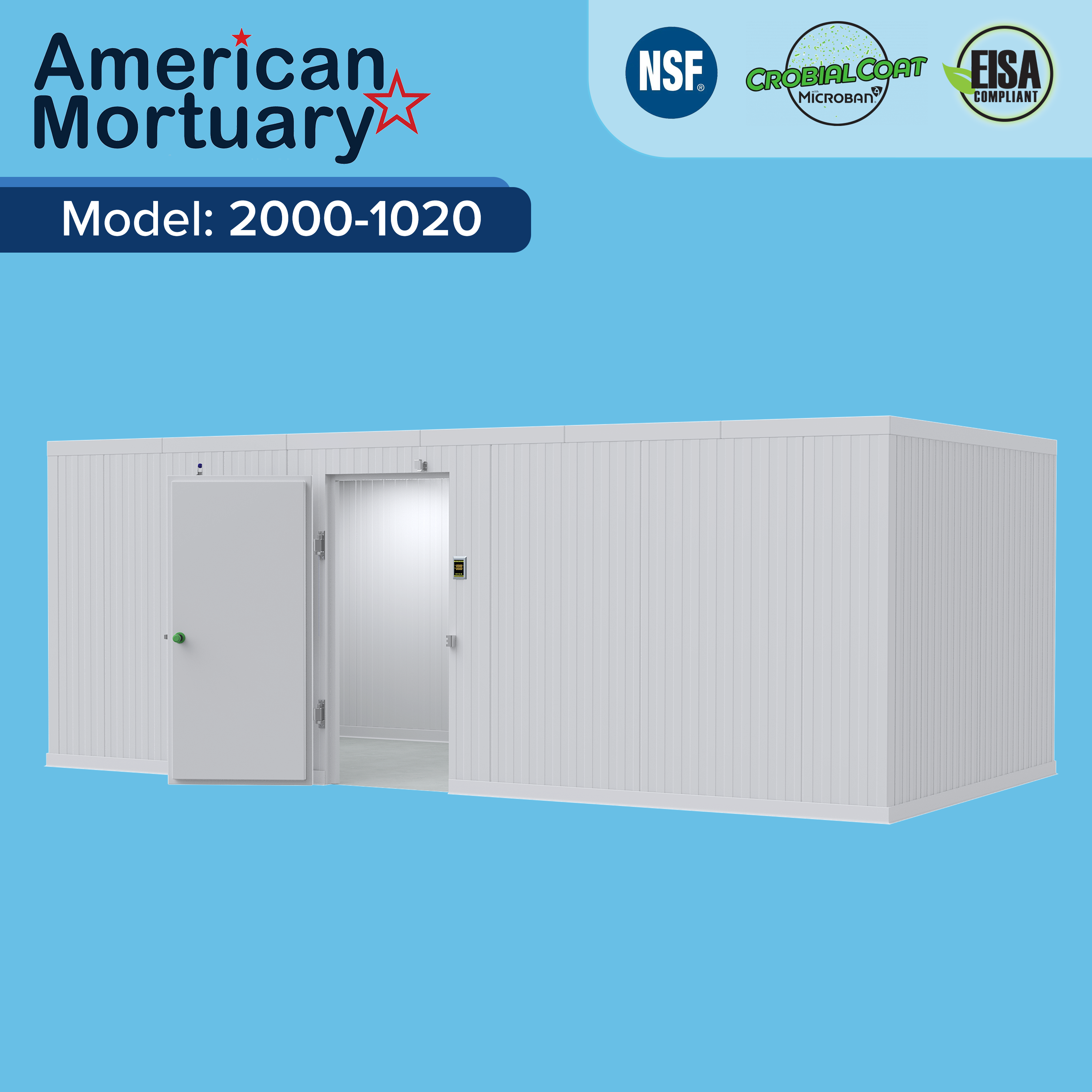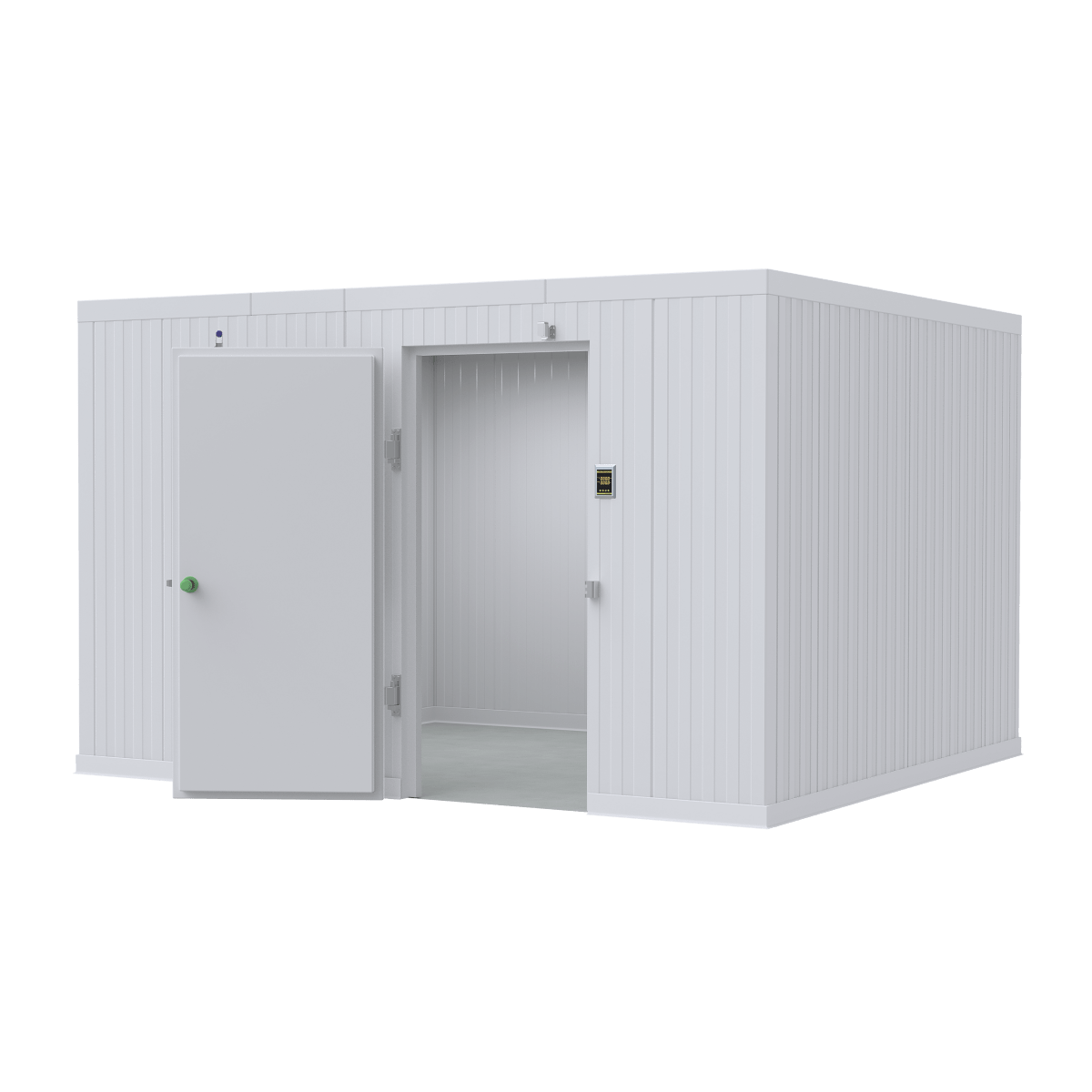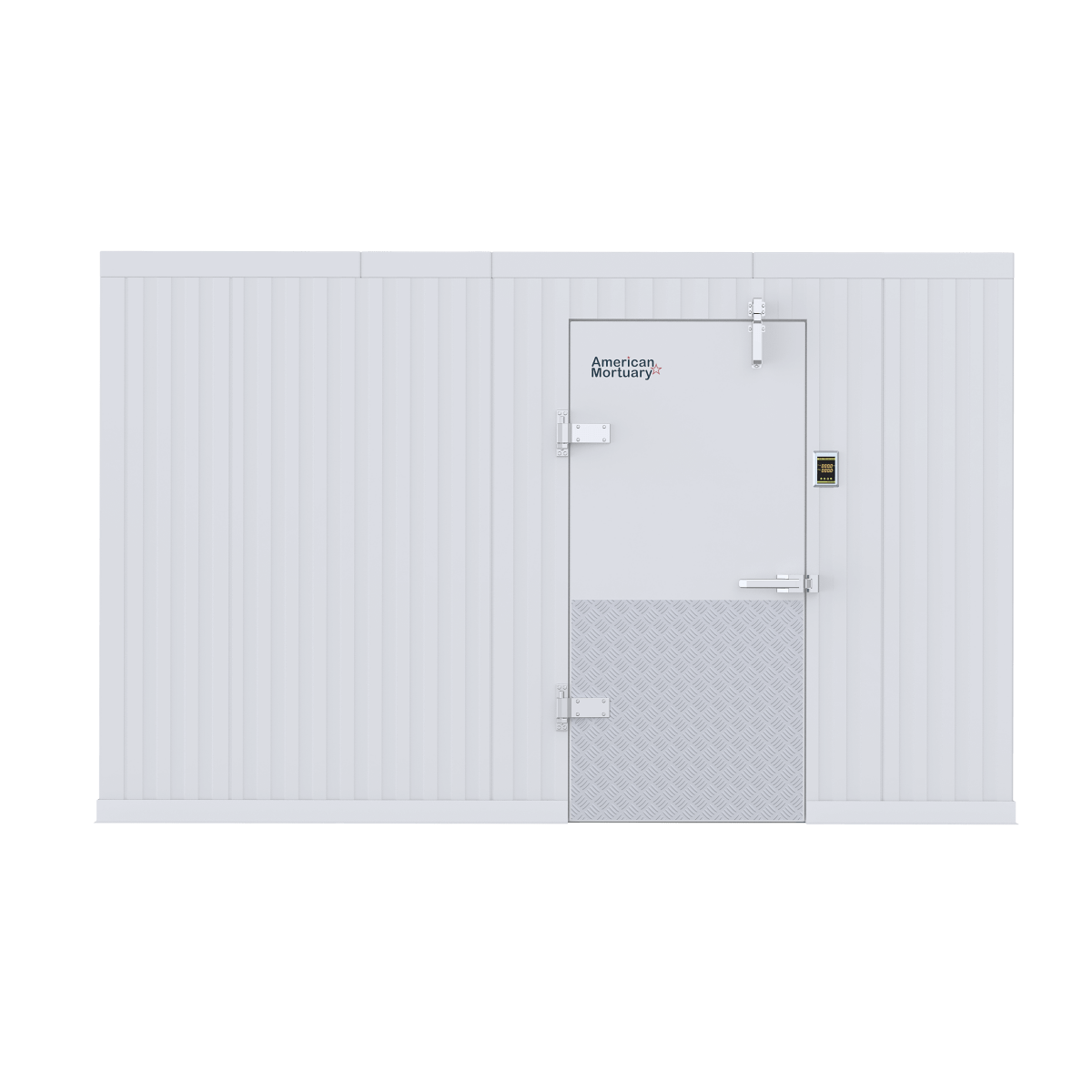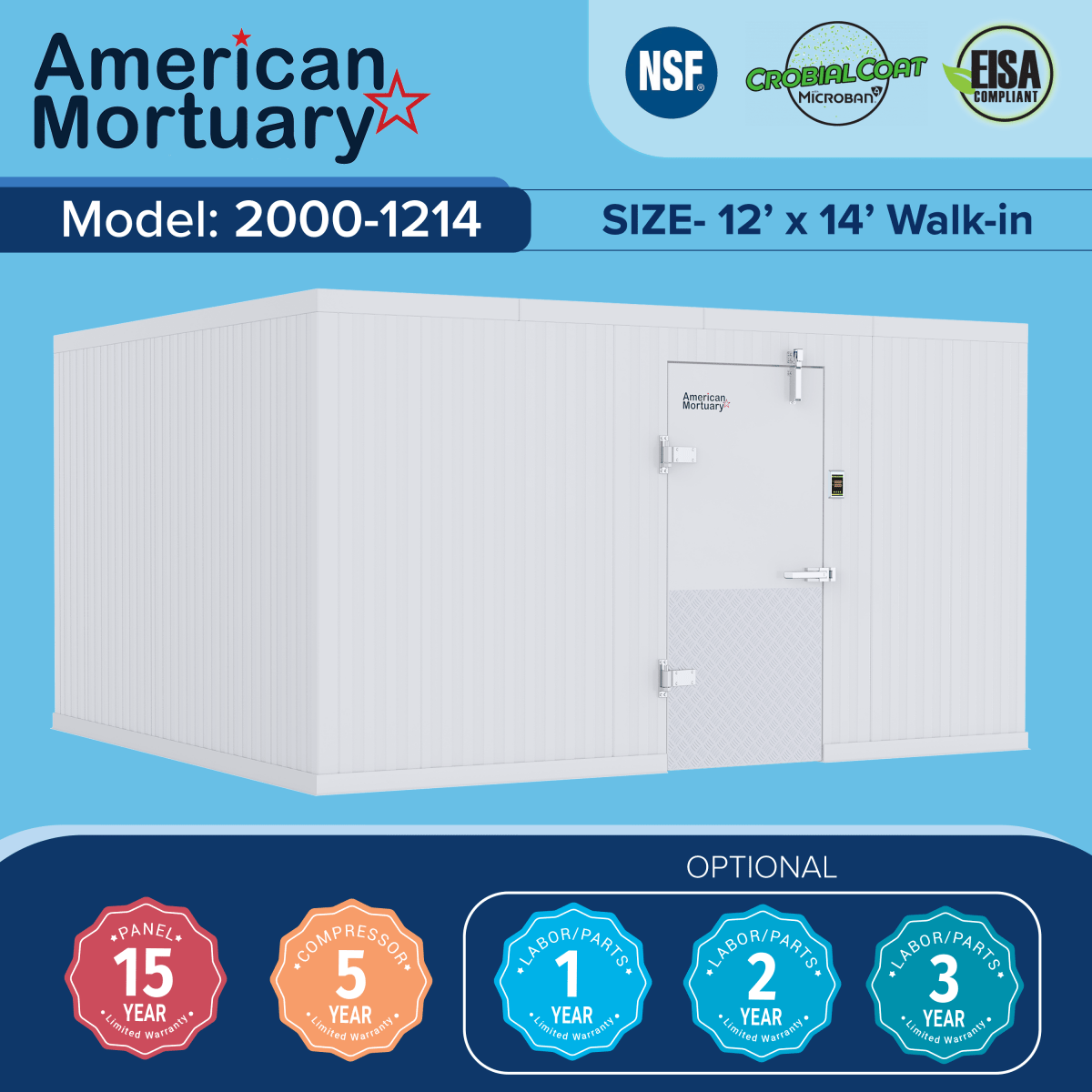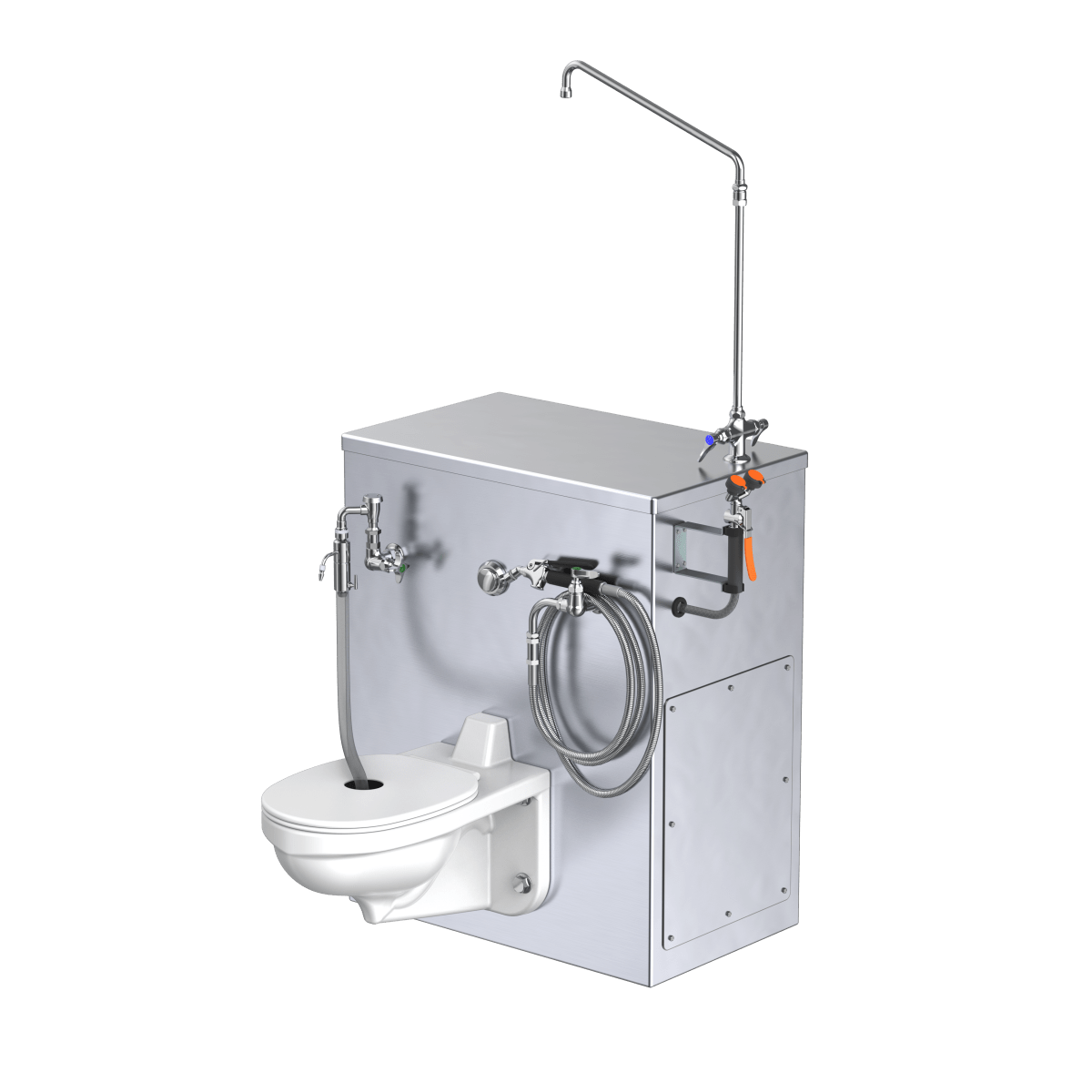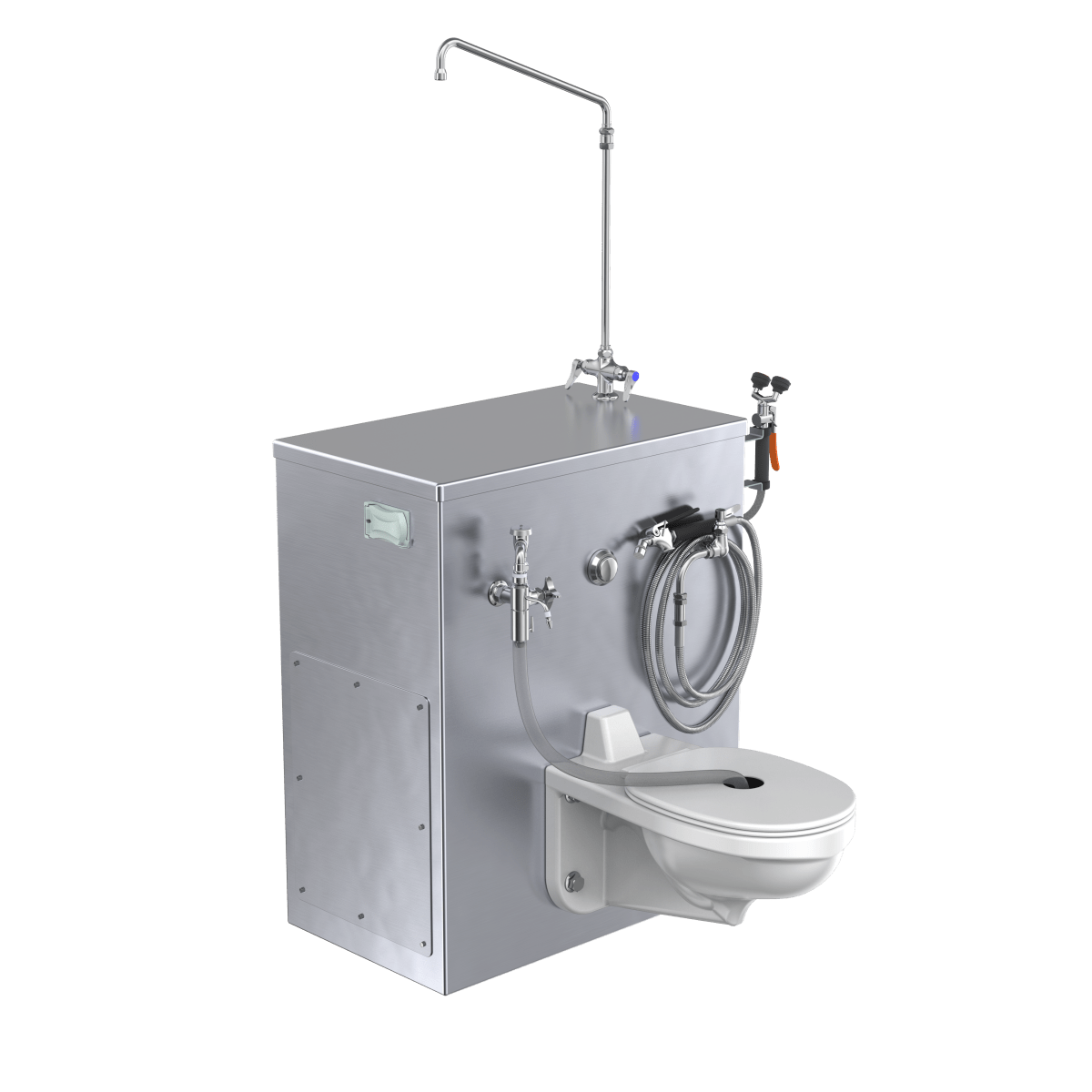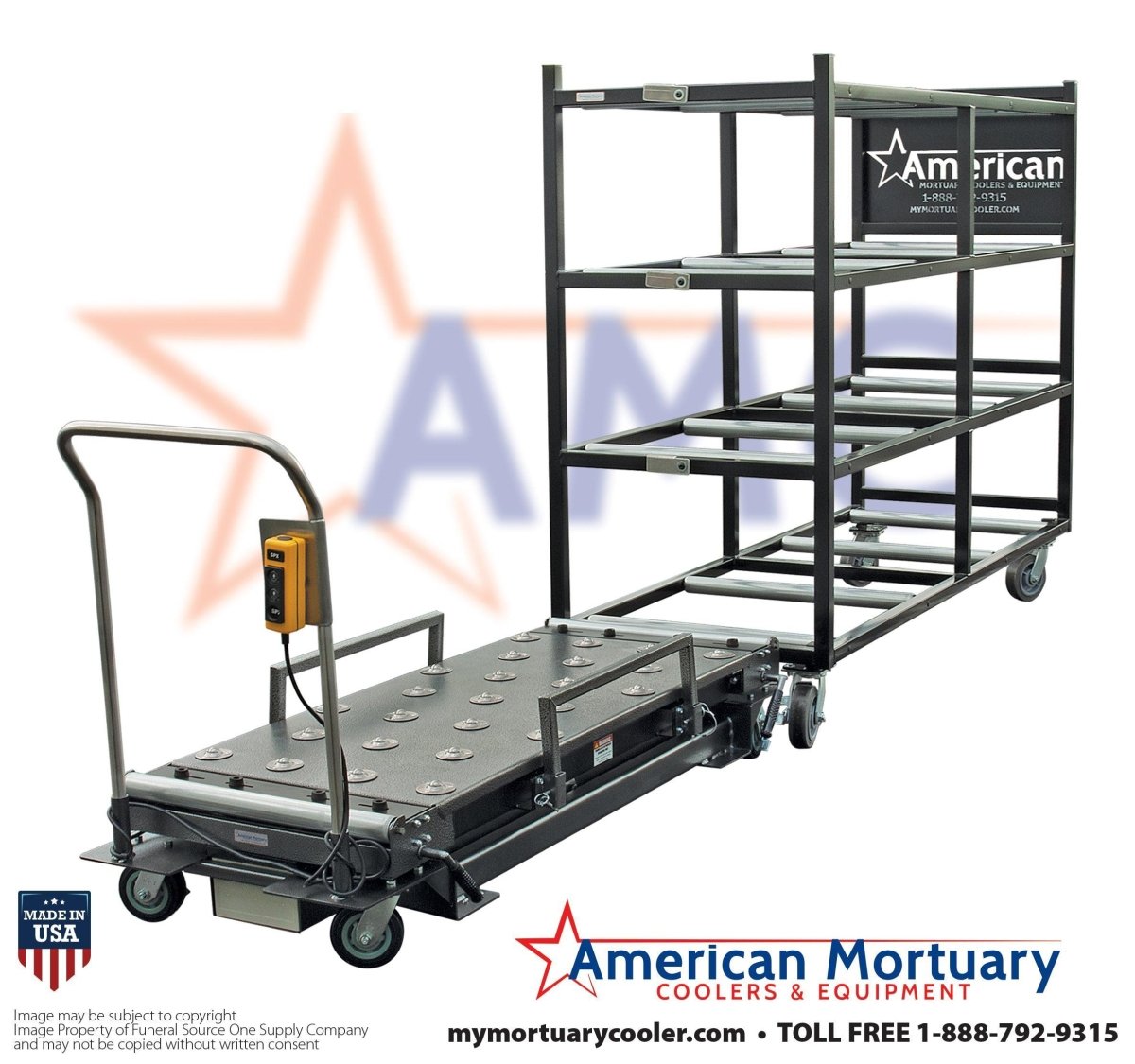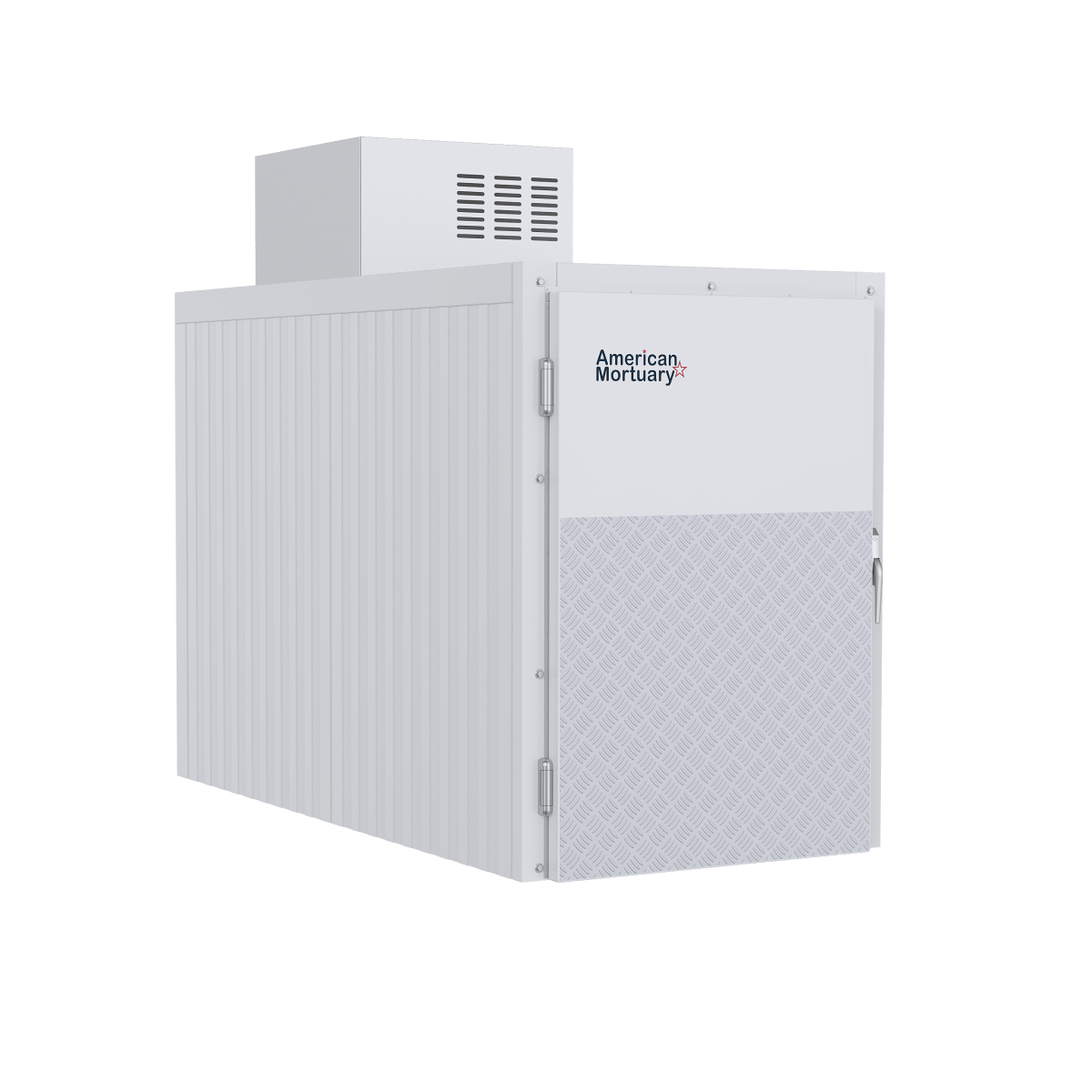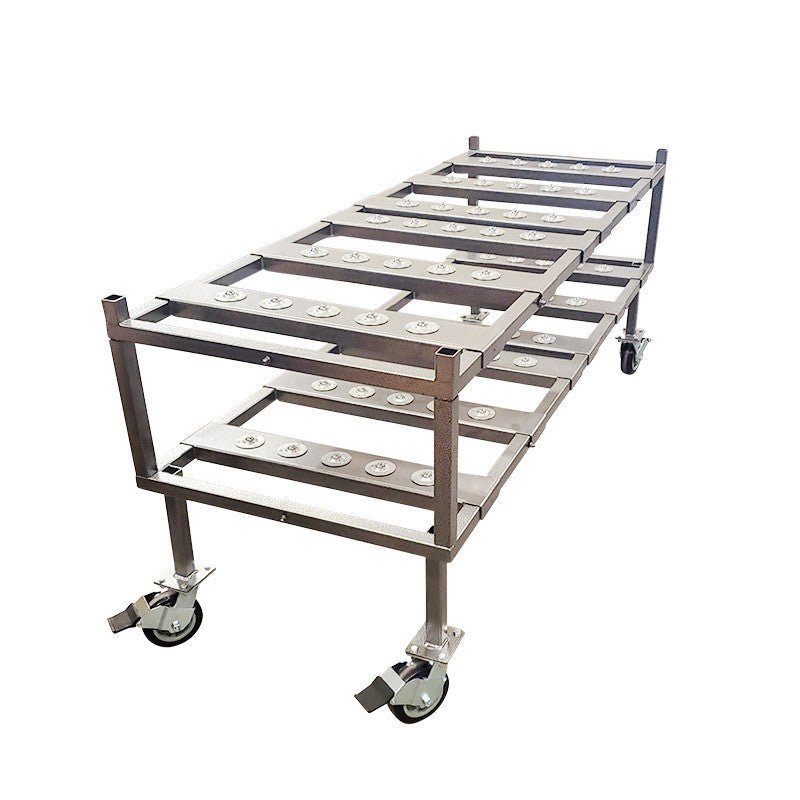The Foundation of Dignified Care: Understanding Mortuary Prep Room Equipment
Mortuary prep room equipment includes essential tools for embalming, body preparation, storage, and sanitation in funeral homes. Here's what you need to know:
- Embalming stations - Wall-mounted or center-sink units ($2,800-$22,000)
- Tables & lifts - Hydraulic embalming tables, dressing tables, body lifts
- Refrigeration - Walk-in coolers, upright units, roll-in systems ($5,800-$33,500)
- PPE & safety - Respirators, gowns, eyewash stations, ventilation systems
- Instruments - Trocars, arterial tubes, aspirators, aneurism hooks
- Chemicals - Arterial fluids, cavity fluids, cosmetics, disinfectants
Behind every dignified funeral service lies a well-equipped preparation room where skilled professionals perform their essential work with precision and respect. The average prep room contains over 200 unique items ranging from specialized embalming machines to body storage solutions and personal protective equipment. These tools not only facilitate the technical aspects of preparation but also help ensure compliance with strict OSHA regulations while maintaining the highest standards of care for the deceased.
The right equipment transforms a basic room into an efficient workspace where preparation can be performed safely, respectfully, and with minimal stress on staff. For smaller funeral homes, space-optimizing solutions like folding tables and single-body coolers make the most of limited square footage. Larger facilities often invest in multi-body refrigeration systems, ceiling-mounted lifts, and comprehensive ventilation systems to handle higher case volumes.
I'm Mortuary Cooler, a national-level supplier of mortuary coolers and prep room equipment with extensive experience helping funeral directors select and implement the right mortuary prep room equipment for their specific needs and spaces. My team specializes in American-made solutions built for durability and customized to your facility's requirements.

Mortuary prep room equipment terms to know:
Mortuary Prep Room Basics: Purpose & Layout
The heart of every funeral home isn't the chapel or viewing room—it's the preparation space where dignity, respect, and technical expertise come together. A well-designed prep room serves as the foundation for everything that follows in the funeral process.
At its core, a mortuary prep room supports four essential functions: embalming, restoration, sanitation, and temporary preservation. This specialized workspace isn't just about equipment—it's about creating an environment where funeral professionals can honor the deceased through meticulous care.
Embalming represents the primary technical work performed in the prep room, where blood is replaced with preservative chemicals to create a natural appearance and temporarily preserve the body. Restoration work addresses any trauma or disfigurement, helping families see their loved ones peacefully. Sanitation protocols protect both staff and visitors, while preservation methods maintain dignity throughout the funeral process.
Good ventilation isn't just an OSHA requirement—it's a necessity for the health of your staff. Modern prep rooms feature negative pressure ventilation systems that pull chemical vapors away from embalmers and exhaust them safely outside. These systems protect against formaldehyde exposure while creating a more comfortable working environment.
The flooring beneath your feet matters too. The best prep rooms feature seamless, chemical-resistant floor coatings with gentle slopes toward central drains. This thoughtful design prevents fluid pooling and makes thorough cleaning between cases much easier.
Key Zones in a Prep Room
An efficient prep room flows naturally from one zone to another, supporting your team's workflow while maintaining infection control standards:
The receiving area serves as the transition point where the deceased first enters your care. Many funeral homes design this space with a dedicated entrance from the garage or loading area, sometimes including a scale for accurate weight assessment.
The embalming station forms the heart of your prep room. This central workspace typically features an embalming table, specialized sink, and embalming machine. Bright, shadow-free lighting is essential here, along with reliable water connections and proper drainage.
Your body storage solution—whether a walk-in cooler or individual units—provides temporary preservation before and after preparation. This critical zone needs to balance accessibility with space efficiency.
A secure chemical storage area keeps embalming fluids, disinfectants, and other supplies organized and safely contained. This zone requires proper ventilation and appropriate hazard signage to maintain OSHA compliance.
The PPE station serves as your first line of defense against bloodborne pathogens. This dedicated area should house gloves, gowns, face shields, and respirators. Many modern prep rooms incorporate a "clean" entrance and "dirty" exit pathway to maintain strict infection control.
Finally, a well-designed cleanup area provides space for instrument sterilization, waste disposal, and staff decontamination. This zone typically includes an eyewash station and emergency shower for immediate response to chemical exposure.
Workflow Optimization Essentials
The difference between a stressful and smooth preparation experience often comes down to thoughtful workflow design. Small details make a big difference:
Unobstructed pathways allow your team to move bodies, equipment, and themselves efficiently throughout the space. Tight corners and narrow passages create bottlenecks that slow your work and increase the risk of accidents.
Adjustable-height tables reduce back strain by allowing embalmers to work at the proper ergonomic height for their body type. This simple feature can prevent years of cumulative strain on your staff.
Pass-through coolers represent a game-changer for many funeral homes, allowing bodies to be received from one side and accessed from the prep room. This design minimizes unnecessary movement while improving workflow efficiency.
Foot-operated fixtures like faucets and soap dispensers minimize cross-contamination during procedures. These hands-free solutions maintain sanitation standards while making your team's job easier.
Strategically placed instrument tables keep necessary tools within easy reach during embalming, reducing wasted movement and improving efficiency. Similarly, adequate counter space provides room for chemicals, instruments, and documentation.
At American Mortuary Coolers, we've helped hundreds of funeral directors design prep rooms that balance efficiency with compassion. We understand that your space constraints, case volume, and regional requirements create unique challenges—which is why we offer customized solutions rather than one-size-fits-all approaches.
The mortuary prep room equipment you choose today will impact your operations for years to come. That's why thoughtful planning and expert guidance make all the difference.
Essential Categories of Mortuary Prep Room Equipment
When you walk into a well-equipped prep room, you're surrounded by over 200 distinct items working together to create a dignified final presentation. Understanding these essential tools helps funeral directors make smart choices whether opening a new facility or upgrading an existing one.
Think of mortuary prep room equipment as falling into ten key categories that form the backbone of any preparation space:
Embalming machines pump preservative fluids into the body with precision. Tables and stations provide the workspace where the art of preparation happens. Body lifts ensure staff can safely move and position the deceased without injury. Body storage solutions preserve dignity through refrigeration. Personal protective equipment shields your team from biological and chemical hazards. Chemicals and fluids perform the preservation and restoration work. Instruments and tools allow for detailed, precise work. Sanitation systems maintain a clean, safe environment. Ventilation equipment controls air quality and chemical exposure. And waste management systems ensure everything is disposed of properly and respectfully.
Each piece of equipment plays a specific role in honoring the deceased and supporting the professionals who serve families during their most difficult moments.
Embalming & Body Preparation Tools
The tools of embalming reflect the blend of science and artistry that defines the profession. Each instrument serves a specific purpose in the careful process of preparation:
The trocar—a long, hollow instrument ranging from 16 to 20 inches—allows embalmers to aspirate body cavities and inject cavity fluid with precision. Arterial tubes, available in straight, curved, and slotted vent designs, deliver embalming fluid directly to the circulatory system. When locating and raising arteries, the aneurism hook becomes an invaluable aid.
Aspirators create the necessary suction to remove fluids, while drainage tubes direct them away from the body during the embalming process. For targeted treatment of specific areas, hypodermic syringes offer precise control. When closing incisions, embalmers rely on various sutures and needles, including half-curved, double curved, and specialized post-mortem varieties.
The finer details of preparation—creating natural facial expressions—depend on tools like mouth formers, needle injectors, and eye caps that help achieve a peaceful, natural appearance.
Quality makes all the difference in these instruments. Investing in high-grade stainless steel tools that resist corrosion and maintain their edge through years of use pays dividends in both efficiency and results.
More info about prep room instruments
Tables, Stations & Lifts
At the heart of every prep room stands the embalming table—the foundation of the embalmer's workspace.

Hydraulic embalming tables offer adjustable heights to accommodate different embalmers and procedures, with prices typically ranging from $2,849 to $19,995 depending on features and quality. For smaller spaces, folding embalming tables provide flexibility when square footage is at a premium. Facilities that handle post-mortem examinations may opt for specialized autopsy tables with features like dissection boards and improved drainage systems. For the final steps of preparation, dressing tables—often with folding designs—provide the perfect surface for clothing and casketing the deceased.
Moving bodies safely requires proper equipment to protect both staff and the deceased. Scissor lifts raise from floor level to table height with hydraulic or electric power. Gantry lifts offer portable overhead lifting without requiring permanent ceiling installation. For facilities with adequate structural support, ceiling lifts with tracks can cover multiple preparation areas. And when it comes to moving both bodies and loaded caskets, hydraulic body and casket lifts handle the heavy lifting.
Supporting this primary equipment, utility carts transport instruments and supplies throughout the prep room, while morgue carts and body boards facilitate dignified movement of the deceased within the facility.
Your specific needs—case volume, staff size, and available space—will determine the ideal configuration. At American Mortuary Coolers, we help funeral directors find that perfect balance with custom solutions delivered directly across the country.
Body Storage & Refrigeration
Proper refrigeration preserves dignity and provides time for thoughtful preparation. Today's funeral homes can choose from several effective cooling solutions:
Walk-in coolers offer room-sized storage for multiple bodies on racks, with custom-built solutions starting around $15,000. For more compact needs, upright multi-body coolers stand independently and hold between 2-12 bodies in individual compartments, with prices ranging from $5,799 for single-body units to $33,525 for comprehensive 12-body systems. Roll-in refrigeration units allow bodies to be moved in on carts, while side-loading coolers maximize space efficiency in narrow rooms by loading from the side rather than the end. For easier access without full removal, telescoping slide rails let embalmers pull bodies out partially while keeping them within the cooled environment.
Inside these units, body trays made of stainless steel or plastic provide support for the deceased. In walk-in coolers, cadaver cantilever racks allow adjustable storage of multiple bodies. For transport between storage and preparation, body storage boards offer rigid support, while morgue cart covers maintain privacy during movement through the facility.
When selecting your refrigeration system, consider your typical case volume and seasonal fluctuations, available floor space and ceiling height, energy efficiency for long-term operating costs, accessibility for staff of varying physical capabilities, and your projections for future growth.
At American Mortuary Coolers, we specialize in refrigeration solutions custom-built to your specifications in Tennessee and delivered directly to funeral homes across the contiguous 48 states, ensuring a perfect fit for your unique space.
More info about choosing a funeral home cooler
Personal Protective Equipment (PPE)
Protecting your team is non-negotiable in the preparation room environment. A comprehensive PPE program includes multiple layers of protection:
Nitrile or latex examination gloves provide the first barrier during routine procedures, with heavier-duty versions available for more intensive work. Fluid-resistant gowns and aprons shield clothing and skin from chemical and biological exposure. For respiratory protection, N95 masks offer basic safety, while powered air-purifying respirators (PAPRs) or CAPR systems provide improved protection during higher-risk procedures.
Face shields protect against unexpected splashes and aerosols. Sleeve protectors extend coverage from wrist to upper arm. Booties prevent tracking contaminants outside the preparation area. And hair coverings complete the protective ensemble by preventing contamination of the embalmer's hair.
Beyond personal gear, safety stations provide crucial backup when accidents occur. Eyewash stations allow immediate flushing if chemicals contact the eyes. Emergency showers enable full decontamination after significant exposure. Drench hoses offer flexible alternatives to fixed stations. Formaldehyde test kits help monitor air quality and ensure OSHA compliance. And splash guards attached to tables help prevent splashing during procedures.
Because PPE items are used daily, they're among the most frequently reordered supplies in preparation rooms. We recommend maintaining at least a 30-day supply of these essentials to prevent shortages during busy periods—something your families will never see but that protects the health of your most valuable asset: your preparation professionals.
Chemicals, Fluids & Cosmetics
The chemistry and artistry of embalming require a thoughtful selection of specialized products:
Arterial fluids form the foundation of preservation, injected into the circulatory system in various formulations and "index" strengths (typically 20-36) to address different preservation needs. For body cavities after aspiration, stronger cavity fluids provide thorough treatment of internal spaces.
To improve the effectiveness of arterial fluids, co-injection fluids address specific challenges: humectants maintain tissue moisture, dye additives improve natural coloration, water conditioners optimize fluid effectiveness, anti-edema compounds reduce swelling, and jaundice treatments counter yellow discoloration.
When restoration is needed, restorative materials help rebuild damaged features: feature builders with wax-like consistency allow for reconstruction, hardening compounds reinforce damaged areas, and sealants close wounds or incisions with invisible results.
The final touch comes from specialized cosmetics designed specifically for mortuary use: foundations in various skin tones create a natural base, lip tints restore lifelike color, finishing powders set makeup while reducing shine, and airbrush systems deliver even, natural-looking application.
The chemical inventory of a well-stocked prep room typically includes preservative arterial fluids as primary embalming agents, waterless arterial fluids for challenging edema or jaundice cases, specialty cavity fluids targeted for specific conditions, tissue builders to improve sunken features, massage creams for restoring pliability, disinfectant sprays for surface sanitization, and odor neutralizers for addressing specific challenging conditions.
Selecting the right chemicals depends on the deceased's condition, time between death and embalming, medical history, and the desired final appearance. Our team at American Mortuary Coolers can help you build an inventory custom to your typical case mix and regional climate considerations, ensuring you're prepared for whatever comes through your doors.
Mortuary Prep Room Equipment & OSHA-Compliant Safety
Let's face it—safety isn't the most exciting topic, but in a prep room, it's absolutely essential. When you're handling chemicals that could make your eyes water from across the room, having the right safety equipment isn't just good practice—it's the law.
OSHA regulations might seem like a headache, but they exist for good reason. The main standards affecting mortuary prep room equipment protect both you and your staff from very real hazards:
The Bloodborne Pathogens Standard prevents exposure to potentially infectious materials—something funeral professionals encounter daily. The Formaldehyde Standard keeps tabs on those strong-smelling chemicals that are necessary for preservation but tough on lungs. Meanwhile, the Hazard Communication Standard ensures everyone knows exactly what chemicals they're working with, and the Personal Protective Equipment Standards make sure you're properly shielded from head to toe.
What does this mean in practical terms? Your prep room needs proper ventilation—8-12 air changes per hour, with exhaust vents placed at floor level where formaldehyde (being heavier than air) tends to concentrate. You'll need spill kits ready for the inevitable accidents, and sharps containers to safely dispose of used needles and scalpels.
Clear signage isn't just for show—it reminds everyone of hazards and emergency procedures when stress levels are high. Eyewash stations and emergency showers must be accessible within a quick 10-second dash from anywhere in the room. And yes, something as simple as strategically placed glove dispensers can make compliance much easier during busy times.
Modern equipment like the PrepArm system ($3,782) and SB-200 air purifiers ($2,379) specifically target formaldehyde vapors, making compliance easier while creating a healthier workspace.
Required PPE & Safety Devices
The right personal protective equipment creates a crucial barrier between you and potential hazards. OSHA requires N95 respirators rated specifically for formaldehyde exposure—and yes, those annual fit tests are mandatory, not optional. For staff who can't use N95s or for particularly challenging cases, CAPR systems (Controlled Air Purifying Respirators) provide improved protection.
Your hands are your most important tools, so protect them with chemical-resistant gloves appropriate for the specific solutions you're using. Fluid-resistant gowns or aprons should cover your torso and arms completely, while face shields or goggles protect against unexpected splashes that can happen during arterial injection or cavity treatment.
Beyond personal gear, your prep room should include splash guards attached to embalming tables—these simple shields dramatically reduce fluid exposure. Vented sinks minimize chemical aerosolization, while dedicated air purifiers filter the overall environment. The PrepArm ventilation system captures formaldehyde vapors right at the source, and formaldehyde monitors ensure levels stay below OSHA's limit of 0.75 parts per million.
At American Mortuary Coolers, we build safety features directly into our equipment. Our custom mortuary coolers include positive-latching doors with internal emergency releases (because no one should ever get trapped inside), non-slip flooring to prevent falls, and ergonomic handles designed for staff of all heights and strengths.
Training & Documentation
Even the best safety equipment is ineffective without proper training and documentation. This paperwork might seem tedious, but it's your best defense during an OSHA inspection.
Safety Data Sheets for all chemicals must be readily available—not locked in an office or buried in a drawer, but accessible when needed. Those annual respirator fit tests? They need documentation for each employee. If someone is exposed to blood or formaldehyde above permissible limits, exposure logs must be completed and maintained.
Regular formaldehyde monitoring proves you're keeping chemical levels in check, while training records verify that everyone knows how to use equipment properly and respond to emergencies.
I've found that keeping a dedicated safety binder, regularly updated and reviewed during staff meetings, saves tremendous headaches during inspections. This simple organization system can prevent costly citations while ensuring everyone goes home safely at the end of each day.
Compliance isn't just about avoiding fines—it's about creating a workspace where your team can perform their important work safely and efficiently. The right mortuary prep room equipment makes this possible while showing your staff that their wellbeing matters.
Comparing Embalming Machines, Stations & Fluids
When it comes to the heart of your prep room, not all embalming machines are created equal. I've helped hundreds of funeral directors find their perfect match, and the differences between models can significantly impact your daily operations.
The Mark V Porti-Boy remains a popular choice for smaller facilities at around $2,849.95. It's portable, reliable, and operates on a gravity-feed system that many embalmers find intuitive. On the other end of the spectrum, the Duotronic V offers all the bells and whistles – programmable pressure settings, digital controls, and improved monitoring capabilities – with a premium price tag around $21,995. For many mid-sized operations, the Duotronic III hits the sweet spot at approximately $4,995, offering electronic pulsation control without breaking the bank.
What really matters when selecting an embalming machine? Pressure control capabilities range from manual adjustments on basic models to precise digital settings on advanced units. Pulsation features mimic the natural heartbeat, improving fluid distribution throughout the body – something particularly valuable for challenging cases. Higher-end machines also offer flow rate monitoring to track exactly how much fluid you're using, which helps with both documentation and inventory management.
| Machine Model | Type | Pressure Range | Pulsation | Price Range | Best For |
|---|---|---|---|---|---|
| Mark IV/V Porti-Boy | Portable/Gravity | Manual | No | $2,800-$3,500 | Small facilities, mobile services |
| Duotronic II | Electronic | 0-15 psi | Yes | $3,900-$4,500 | Medium-sized funeral homes |
| Duotronic III | Electronic | 0-30 psi | Yes, variable | $4,500-$5,500 | Busy funeral homes |
| Duotronic V | Electronic | 0-45 psi, programmable | Yes, programmable | $19,000-$22,000 | High-volume facilities, teaching institutions |
| Solo Machine Fill | Accessory | N/A | N/A | $800-$1,200 | Add-on for existing machines |
I've found that many funeral homes overlook drain tube features when comparing machines, but the difference between basic and vacuum-assisted drainage can significantly impact your efficiency. Similarly, if you offer removal services or work between multiple locations, the portability of your embalming machine becomes a crucial consideration.
Selecting the Right Embalming Station
Your embalming station is where the magic happens – the workspace that can either improve or hinder your daily operations. Wall-mount stations save valuable floor space and work beautifully in compact prep rooms. Center-sink stations offer 360-degree access, ideal for teaching situations or when multiple people might be working on a case. Combination stations integrate your embalming machine, sink, and instrument storage into one cohesive unit, reducing clutter and streamlining your workflow.
When I'm helping funeral directors choose an embalming station, I always point out a few critical details that make a difference in daily use. The stainless steel gauge matters – remember, lower numbers mean thicker, more durable construction that will withstand years of chemical exposure. Flush valves might seem like a minor feature until you're dealing with drainage issues and wishing you had them. A generous backsplash height prevents wall damage and makes cleanup easier after challenging cases.
Don't overlook the importance of integrated instrument holders that keep your tools organized and within reach. And while they might cost a bit more upfront, foot-operated faucets prevent cross-contamination and become second nature after just a few cases.
Your available space and budget will largely determine which style makes sense for your facility. Wall-mount stations work beautifully in smaller prep rooms (under 200 sq ft), while center-sink stations provide more workspace in larger facilities where multiple staff members might be working simultaneously.
Matching Fluids to Case Needs
Selecting the right embalming fluid is truly an art form that makes all the difference in your results. High-index fluids (30-36 index) provide the preservation power needed for delayed embalming or difficult cases where decomposition has begun. For most standard cases, medium-index fluids (24-28 index) offer an excellent balance of preservation and natural appearance. When working with children, autopsied cases, or when minimal firming is desired, low-index fluids (18-22 index) are typically your best choice.
Beyond the basics, today's mortuary prep room equipment includes specialized fluids for specific conditions. Jaundiced cases benefit from treatments with specialized dyes that counteract yellow discoloration. Emaciated cases can be improved with tissue builders that restore a more natural appearance. Edema cases respond well to waterless formulas that don't add additional fluid to already swollen tissues.
The science behind embalming continues to evolve, with a growing focus on reducing formaldehyde exposure for funeral professionals. Research published in the Journal of Environmental and Public Health has shown that proper ventilation combined with lower-index fluids can significantly reduce workplace exposure while maintaining excellent preservation results. This is something we take seriously at American Mortuary Coolers.
Scientific research on formaldehyde exposure
We've developed relationships with leading chemical manufacturers to help our clients select products that match their typical case mix, regional climate considerations (humidity makes a difference!), and staff safety preferences. After all, the mortuary prep room equipment you choose should not only honor the deceased but also protect the health of those serving families day after day.
Storage, Hygiene & Maintenance Best Practices
Keeping your prep room clean isn't just about meeting regulations—it's about honoring your commitment to families and maintaining professional standards. A well-maintained facility reflects your dedication to excellence in every aspect of your service.

I've worked with hundreds of funeral homes, and those with the most efficient operations follow a tiered maintenance schedule. Daily sanitation after each case prevents cross-contamination and maintains a professional environment. This includes wiping down all surfaces with appropriate disinfectants and properly disposing of single-use items.
Taking time for weekly deep cleaning pays dividends in equipment longevity and staff health. This deeper clean involves disassembling and properly sterilizing frequently used instruments. Many funeral directors tell me they schedule this for a consistent day each week, often when case volume is typically lower.
Don't overlook the importance of monthly maintenance checks on your mechanical systems. Your embalming machines, ventilation systems, and refrigeration units need regular attention to prevent costly emergency repairs. A simple inspection log can help track these activities and identify potential issues before they become problems.
Quarterly formaldehyde testing isn't just about compliance—it's about creating a safer workplace for your team. Modern mortuary prep room equipment includes monitoring systems that can alert you when levels approach concerning thresholds.
For effective sanitation, consider investing in an over-table wash system that mounts above your embalming table. These systems provide thorough rinsing capabilities that standard faucets simply can't match. Paired with proper instrument sterilization trays, they form the backbone of your hygiene protocol.
Many funeral directors I've worked with have found that designated linen hampers with biohazard markings help maintain clear boundaries between clean and soiled materials. Similarly, implementing a thoughtful waste segregation system—clearly marked containers for regular waste, biohazardous materials, and sharps—prevents dangerous disposal mistakes.
Small Funeral Homes vs Large Facilities
"Right-sizing" your mortuary prep room equipment might be the most important decision you'll make when outfitting your facility. I've seen too many small funeral homes struggling with oversized equipment that dominates their limited space.
If you're handling fewer than 100 cases annually, consider space-saving options like single-body coolers ($5,799-$8,999) or compact upright units. These provide necessary refrigeration without overwhelming your prep room. Folding embalming tables can be a game-changer in tight spaces, allowing you to reconfigure the room as needed. Portable lifts offer flexibility without the commitment of ceiling-mounted systems.
Medium-sized operations (100-300 cases yearly) benefit from more dedicated equipment. A 2-3 body refrigeration system provides adequate capacity while wall-mounted embalming stations maximize your available floor space. At this volume, the efficiency gains from basic hydraulic lift systems and mid-range electronic embalming machines justify their cost.
Large facilities handling over 300 cases annually require industrial-strength solutions. Walk-in coolers or multi-body refrigeration systems (6-12 capacity) provide the necessary storage capacity for high-volume operations. Multiple preparation stations allow simultaneous cases, while ceiling-mounted lift systems covering different areas reduce staff strain and improve workflow.
Whatever your size, consider how your needs might change in the coming years. The modular design of modern mortuary prep room equipment allows for expansion as your business grows. At American Mortuary Coolers, we've helped funeral homes from Atlanta to New York and Chicago to Los Angeles create scalable solutions that evolve with their business.
Innovations & Emerging Tech
The mortuary profession may be steeped in tradition, but that doesn't mean we can't accept helpful innovations. Today's technology offers exciting improvements in safety, efficiency, and results.
Touchless fixtures have become increasingly popular, especially since 2020. Sensor-operated faucets and soap dispensers reduce cross-contamination risks while making the preparation process more efficient. These seemingly small upgrades can significantly impact your daily workflow.
Smart ventilation systems represent a major leap forward in prep room safety. These systems monitor chemical levels in real-time and automatically adjust airflow to maintain safe working conditions. The peace of mind they provide is worth the investment for many funeral directors I've worked with.
For those in areas with seasonal case fluctuations or disaster response needs, mobile morgue trailers offer deployable refrigeration that can be activated when needed. These units provide flexibility without requiring permanent facility expansion.
Before committing to a layout, consider using 3D workspace modeling services. These computer-aided designs allow you to visualize different configurations and identify potential workflow issues before construction begins. Many funeral directors tell me this step saved them from costly mistakes.
The shift toward eco-friendly embalming fluids continues to gain momentum. These formulations with reduced formaldehyde content not only decrease environmental impact but often create a safer working environment for your staff. They represent the industry's commitment to responsible innovation.
Common Mistakes to Avoid
After helping hundreds of funeral homes outfit their prep rooms, I've noticed some recurring pitfalls that can cause headaches down the road.
Perhaps the most common mistake is underestimating refrigeration needs. Seasonal fluctuations can create unexpected capacity challenges, and nothing creates more stress than inadequate storage during busy periods. It's always better to have slightly more capacity than you think you'll need.
Running out of essential protective equipment creates both safety risks and compliance issues. Mortuary prep room equipment should include adequate storage for PPE, making it easy to monitor inventory levels and reorder before supplies run low.
Poor drainage planning can turn a minor spill into a major problem. Proper floor slopes and strategically placed drains prevent pooling and make cleanup faster and more thorough. This seemingly technical detail has a significant impact on daily operations.
I've seen too many funeral directors neglect regular maintenance until something breaks. Establishing and following maintenance schedules extends equipment lifespan and prevents disruptions to your service. Think of it as an investment in reliability rather than an expense.
Cramming too much equipment into a small space might seem efficient, but it actually impedes workflow and creates hazards. A thoughtfully designed prep room with adequate clearance around key equipment makes for a safer, more pleasant working environment.
Insufficient lighting leads to mistakes and eye strain, while inadequate ventilation puts staff health at risk. These fundamental elements of prep room design shouldn't be afterthoughts or areas to cut corners.
At American Mortuary Coolers, we've helped funeral directors recover from these mistakes, but we'd much rather help you avoid them altogether. Our team provides honest assessments of space requirements and equipment needs based on your specific situation, ensuring you get the right solution the first time.
More info about prep room supplies
Budgeting, Supplier Selection & Cost Insights
Let's talk dollars and cents – because outfitting a prep room is a significant investment that deserves careful planning. When funeral directors ask me about costs, I'm always straight with them about what to expect.
For refrigeration, you're looking at quite a range. A basic single-body cooler starts around $5,799, while larger 12-body units can reach $33,525. If you need a walk-in cooler, plan on starting around $15,000 for a basic model. These are substantial investments, but remember – proper body storage is the foundation of your preparation services.
Your embalming machine is another cornerstone purchase. The trusty Porti-Boy models begin around $2,849.95 – these workhorses have been industry standards for decades. At the high end, the advanced Duotronic V systems with all the bells and whistles run upwards of $21,995. The difference? Precision, automation, and durability.
For tables, hydraulic embalming tables typically range from $2,995 to $19,995, with the price reflecting weight capacity, adjustment features, and materials. A good ventilation system – which protects your most valuable asset, your staff – runs about $3,782 for a PrepArm system, while comprehensive room solutions can exceed $10,000.
Don't forget the ongoing expenses! Personal protective equipment and consumables generally cost between $200-$500 monthly, depending on your case volume. These aren't optional – they're essential for both safety and compliance.
The good news? Most suppliers offer financing options with terms from 24 to 60 months. Refrigeration units often qualify for equipment leasing programs, which might provide tax advantages – always worth discussing with your accountant.
One tip I share with funeral directors: find a supplier with same-day shipping for orders placed before noon. When you suddenly run low on a critical supply, this service becomes invaluable. At American Mortuary Coolers, we understand that waiting isn't an option in your business.
More info about prep room supplies
Vetting Reliable Suppliers
Finding the right partner for your mortuary prep room equipment needs goes beyond just comparing price tags. Think of your supplier as a long-term partner in your business success.
First, look for inventory breadth – suppliers carrying at least 200+ prep room items offer true one-stop convenience. This saves you from juggling multiple vendors and shipments. OSHA compliance guarantees are non-negotiable; ensure all equipment meets current regulatory standards to avoid costly violations down the road.
Customization capabilities matter tremendously in this business. Every prep room has unique dimensions and challenges, so cookie-cutter solutions rarely work perfectly. Ask potential suppliers about their ability to tailor solutions to your specific space and workflow needs.
Be crystal clear about lead times, especially for custom items. Standard delivery windows versus custom fabrication timelines can significantly impact your planning. Also consider the supplier's proximity to you – shipping zones affect both cost and delivery speed. A supplier with multiple distribution points can save you thousands in shipping over time.
Customer support is often overlooked until you need it urgently. Technical assistance and after-sale service can make the difference between a minor hiccup and a major disruption to your operation. Similarly, warranty terms vary widely – understand what's covered, what's excluded, and for how long.
Finally, clarify installation services upfront. Is professional setup included or will you need separate contractors? This can add unexpected costs if not factored into your initial budget.
At American Mortuary Coolers, we've built our reputation on transparency about these factors. With distribution points across the country – from our home base in Johnson City, TN to regional centers covering every part of the continental US – we provide efficient delivery nationwide, usually within 5-7 business days.
Calculating Total Cost of Ownership
The sticker price is just the beginning of your relationship with any piece of mortuary prep room equipment. Smart funeral directors look beyond initial costs to understand what that equipment will cost over its entire lifespan.
Quality refrigeration units typically serve faithfully for 15-20 years when properly maintained. Embalming machines generally offer 7-10 years of reliable service. These lifespans significantly affect your cost calculations – a unit that costs twice as much but lasts three times longer is actually the better value.
Maintenance requirements vary widely between economy and premium equipment. Annual service costs for embalming machines typically range from $200-$500, but cheaper machines often require more frequent service calls. When I talk with funeral directors about equipment choices, I always emphasize planning for these predictable expenses.
Energy efficiency has become increasingly important as utility costs rise. Modern refrigeration units can be significantly more efficient than older models – potentially saving thousands in electricity costs over their lifespan. This is especially true for larger units running 24/7/365.
Even your chemical consumption can be affected by equipment choice. Efficient embalming machines with precise pressure control can reduce fluid usage by 15-20% compared to older models. At today's chemical prices, these savings add up quickly.
Don't overlook the human factor either. New equipment may require staff training time, temporarily reducing productivity. And the cost of downtime from equipment failure can far exceed repair expenses – especially during your busiest periods.
I've seen how investing in higher-quality equipment often results in lower total ownership costs despite higher initial prices. Our team at American Mortuary Coolers takes the time to help funeral directors understand these tradeoffs and make financially sound decisions for their specific situations and budget constraints.
Frequently Asked Questions about Mortuary Prep Room Equipment
What minimum equipment is required to open a prep room?
When funeral directors ask me about starting a new prep room, I always emphasize that quality basics are better than cutting corners. For a functional prep room that meets both regulatory requirements and professional standards, you'll need several key pieces of mortuary prep room equipment.
Start with a reliable embalming machine – basic models like the Porti-Boy begin around $2,849. Pair this with an embalming table (starting at $2,995 for standard models, though I typically recommend investing in a hydraulic option if budget allows). Refrigeration is non-negotiable – a single-body unit starts around $5,799, which works for very low-volume operations.
Don't overlook your instrument set – expect to invest $1,500-$2,500 for quality stainless steel tools that will last years with proper care. Initial PPE and safety equipment will run about $1,000, though remember these are consumables you'll regularly reorder.
Proper ventilation isn't optional – a PrepArm system starting at $3,782 helps keep your team safe from chemical exposure. You'll also need appropriate drainage, plumbing, chemical storage cabinets, and basic sundries.
All told, most new prep rooms require an investment of $18,000-$25,000 for essential equipment, not including any building modifications for utilities. It seems substantial upfront, but quality equipment pays dividends in reliability, staff safety, and the dignity with which you can serve families.
How often should formaldehyde levels be tested?
Formaldehyde testing is something I find many funeral homes don't prioritize until there's a problem – but by then, staff may have already experienced unnecessary exposure. OSHA has clear guidelines that protect your team and keep you compliant.
When you first begin using formaldehyde-containing products, initial monitoring establishes your baseline. After that, if levels fall between 0.1 and 0.5 parts per million (ppm), testing should occur at least every six months. If levels creep above 0.5 ppm, that frequency increases to quarterly testing.
Any time you change processes, products, or ventilation systems, additional testing is warranted. And if staff report symptoms like eye irritation, respiratory issues, or headaches, immediate testing should be conducted regardless of your regular schedule.
The good news? Formaldehyde test kits are relatively affordable at $40-$60 per test. I recommend keeping detailed testing records even when results show levels below OSHA's action threshold. This documentation proves invaluable during inspections and helps track ventilation effectiveness over time.
Which cooler style fits a 300-sq-ft facility?
Space constraints are a common challenge, especially in older funeral homes or urban locations. For a modest 300-square-foot prep room, every inch counts, but you still have several solid refrigeration options.
Upright 2-3 body coolers offer excellent capacity while consuming just 12-15 square feet of floor space. These units range from $8,999 to $12,999 and work well against walls, preserving your central workspace. For ultimate flexibility, single-body roll-in coolers require only 8-10 square feet each and can be positioned in corners or along walls. Starting around $5,799, these allow you to add capacity incrementally as your business grows.
Many of my clients with tight spaces prefer side-loading coolers with telescoping rails. These clever units allow bodies to be loaded from the side rather than requiring clearance at both ends, saving valuable square footage. Prices typically range from $9,999 to $15,999 depending on capacity.

At American Mortuary Coolers, we've helped countless funeral homes in tight urban spaces from Boston to San Francisco maximize their refrigeration capacity. Our team can create custom solutions that work with your specific room dimensions, doorways, and workflow needs. Remember – a thoughtfully designed small space often functions better than a poorly organized large one.
Conclusion
Choosing the right mortuary prep room equipment isn't just a business decision—it's a commitment to excellence that touches every family you serve. From creating peaceful final memories for loved ones to keeping your team safe and efficient, quality equipment forms the backbone of exceptional care.
Here at American Mortuary Coolers, we've walked alongside funeral directors across the country, learning that no two funeral homes are quite alike. Your needs are shaped by your unique space, the communities you serve, your regional climate (which affects preservation needs), and of course, your budget realities. That's why we don't believe in one-size-fits-all solutions.
Our Tennessee craftsmen take pride in building mortuary coolers and equipment that feel custom-made because they actually are. When you order from us, you're not getting warehouse inventory—you're getting equipment designed specifically for your facility and workflow. And since we deliver directly to all 48 contiguous states, funeral homes from Maine to California receive the same personalized service.
While the initial price tag matters (we understand budget constraints are real), we've seen time and again how investing in quality equipment pays off over years of reliable service. The most expensive cooler is the one that fails during a summer heat wave or needs constant repairs. Our customers tell us that the peace of mind from knowing their equipment won't let them down is worth every penny.
Whether you're opening a new location, renovating an aging prep room, or simply upgrading one piece at a time, our team is here to help. Our regional representatives understand the specific challenges faced by funeral homes in their areas—from the humidity challenges in the Southeast to the space constraints of Northeast urban funeral homes to the temperature extremes in the Southwest.
At the end of the day, the equipment in your prep room does more than just technical work—it helps you fulfill your promise to families during their most vulnerable moments. When everything works smoothly behind the scenes, you can focus completely on providing the compassionate care that sets your funeral home apart.
We'd love to be part of your story. Reach out today to discuss how we can help equip your prep room with solutions as dedicated to excellence as you are.



